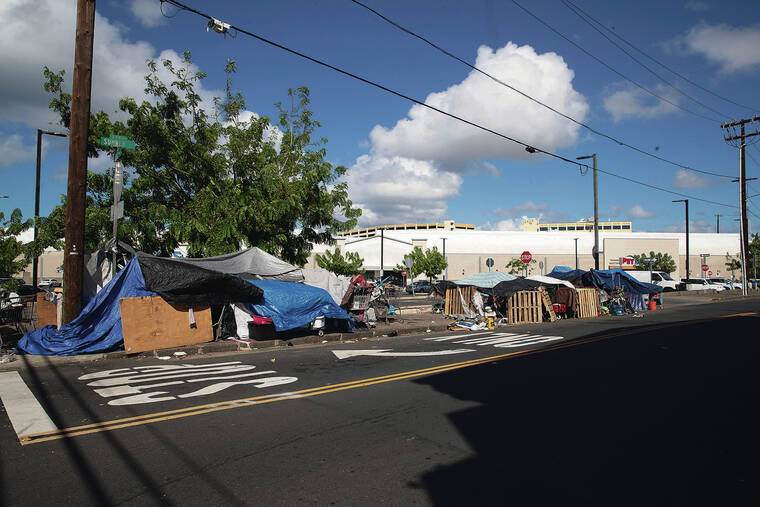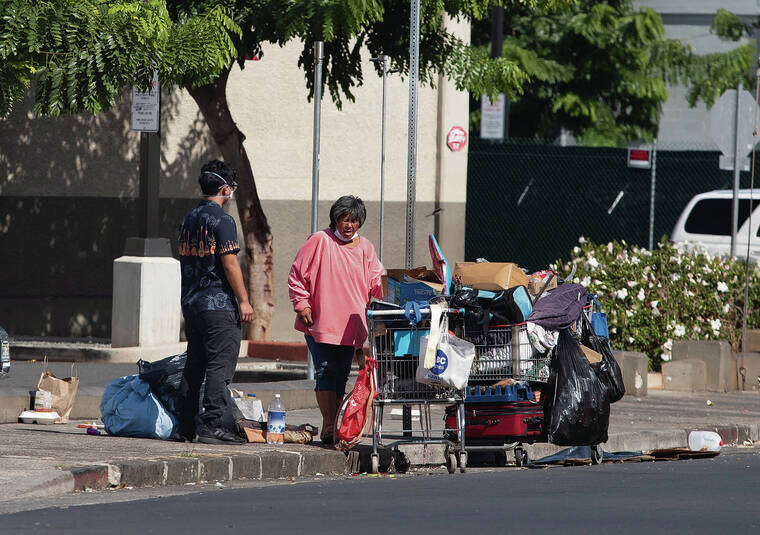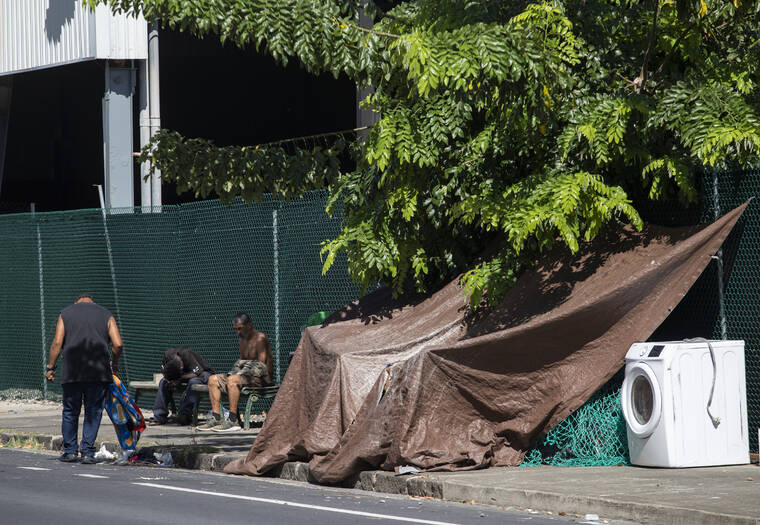As Oahu’s summer tourism season comes to its traditional Labor Day end, the main Nimitz Highway corridor that visitors use to get from Daniel K. Inouye International Airport into Waikiki last week was unusually clear of homeless encampments.
From the airport to Ala Moana Boulevard in Kakaako, only a single blue tarp was erected along Nimitz Highway, underneath the Salvation Army sign in Iwilei.
Five tarp-covered encampments — buttressed by wooden pallets — lined side by side on Sumner Street across the Institute for Human Services, Hawaii’s largest homeless shelter. At the other end of Sumner Street, another dozen or so encampments stretched out along Iwilei Road, which runs perpendicular to Sumner Street and parallel to Nimitz Highway.
A man named Rick said he has been living homeless in the area for years and that he and his neighbors moved their encampments to Sumner Street after having been swept out of the grassy turnaround in the middle of Nimitz Highway “a couple of weeks ago.”
He did not know which agency was responsible for the sweep, or whether it was the state or city or both.
The scene in Iwilei last week represented just a snapshot of an area that has dealt with unwanted homeless activity for years, in particular because of the risk of injury to those who sleep on the side of Nimitz Highway and sometimes dangle their feet and legs into busy traffic, along with their belongings.
The chronically homeless who live in the area are often stubborn to accept offers of help, including shelter and housing, because they can simply walk back and forth between state-owned Nimitz Highway and city-owned sidewalks, such as those on Sumner Street and Iwilei Road, when sweeps occur by either the city or the state.
“We do ask them to move and we do ask them to go into a shelter, but we can’t make them,” said Anton Krucky, who runs the city’s Department of Community Services, which oversees the office of housing and homelessness. “We have folks who won’t even go 50 feet into shelter” at IHS.
IHS volunteer Caleb Wataoka helped a homeless woman on Sumner Street get into a cab on Friday. The woman came into IHS’ medical clinic with a nasty leg wound that required more advanced care at an emergency room, he said.
The number of encampments around the IHS shelter has certainly been higher than it was on Friday, Wataoka said.
“It’s been way worse,” he said.
Krucky said he regularly visits the area and typically counts no fewer than 20 encampments and no more than 50.
He said he also talks weekly with Scott Morishige, the state’s homeless coordinator, about city and state homeless issues, including the situation in Iwilei.
Krucky and Mayor Rick Blangiardi insist the city’s approach to homeless encampments is focused on “sanitation efforts” to clean up troublesome areas — and not on sweeps of the homeless.
But both approaches offer social service and housing help, along with removing and storing belongings of value in accordance with a court ruling.
At the same time, Krucky said the city is newly focused on homeless people and families who want to get off the street and into permanent housing, such as those who became homeless starting a year ago when the COVID-19-era statewide moratorium on evictions was lifted, sending uncounted numbers of residents into a housing crisis and into the streets.
Krucky came to the Blangiardi administration from a business background and said the city is focusing on the new homeless demographic, along with the chronically homeless who often have mental health and substance abuse issues and refuse social service help.
Using funds from the federal Coronavirus Aid, Relief, and Economic Security Act, also known as the CARES Act, Krucky said the city since August 2021 has found housing for 301 families and 852 individuals across the island through a new program called Oahu Housing Now.
The idea is to get motivated families and individuals housed as quickly as possible to prevent them from becoming chronically homeless.
Based on his background in business, Krucky said he wants to address the issue of homeless people who want to get housed as any company would assess its customer base by asking: “Do you understand the customer? Do you understand their needs?’ We’ve been working hard.”






